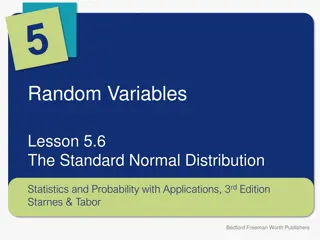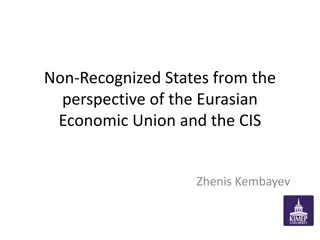Understanding 95% Confidence Intervals in Statistics
Confidence intervals are a key concept in statistics that provide a range within which the true value of an estimate is likely to fall. This video series explores the interpretation of 95% CIs, compares them to standard error and standard deviation, and explains how sample size and standard deviatio
2 views • 8 slides
Ohio Collaborative Standard for Vehicular Pursuit Certification Program 2023
The Ohio Collaborative Community-Police Advisory Board adopted the State of Ohio Standard for Vehicular Pursuit in 2020 to address the risks and dangers associated with vehicle pursuits. This standard aims to govern law enforcement agencies in defining pursuits, criteria for initiation, evaluating c
3 views • 46 slides
Ohio Collaborative Standard for Body-Worn Cameras
The Ohio Collaborative Standard for Body-Worn Cameras outlines guidelines for law enforcement agencies regarding the use of body-worn cameras. It emphasizes the importance of clear policies, accountability, and privacy considerations. Adopted in 2016, this standard aims to enhance trust between poli
0 views • 29 slides
Ohio Collaborative Standard: Investigation of Employee Misconduct
Ohio Collaborative Standard focuses on the investigation of employee misconduct in law enforcement agencies, emphasizing the importance of procedural justice, public respect, and comprehensive investigation processes. It outlines the purpose, learning objectives, and the establishment of written pol
0 views • 29 slides
Understanding Standard Form and Numbers Conversion
Explore the concept of standard form, learn how to write numbers concisely, and practice converting numbers to and from standard form through helpful examples and exercises. Enhance your skills in dealing with big and small numbers efficiently.
2 views • 16 slides
Overview of Unitary, Confederal, and Federal States
Unitary, confederal, and federal states each have distinct characteristics regarding the distribution of power between central and subnational governments. Unitary states have centralized governance, while devolved states like the UK grant autonomy to subnational entities. Decentralized states trans
0 views • 22 slides
Standard Costing: Understanding Variances in Actual vs. Budgeted Costs
Explore the concept of standard costs, variance analysis, and the importance of investigating variances in actual vs. budgeted costs. Learn to calculate and interpret material and labor variances, overhead variances, and participate in a case study to apply learned concepts. Understand the developme
2 views • 52 slides
Issues with SCS Operation in IEEE 802.11be Standard
The document discusses technical issues related to the SCS (Spatial Channel Sharing) operation in the IEEE 802.11be standard. It highlights inconsistencies in the standard regarding parameterized QoS requirements, mixing of traffic streams with different QoS needs, and challenges in prioritizing SCS
0 views • 15 slides
Understanding Motion and Measurement of Distances in Science at Sainik School Gopalganj
Explore the concepts of motion and measurement of distances in science as taught by Dr. A.K. Choubey at Sainik School Gopalganj. Discover the development of means of transport, different measurement methods like non-standard and standard measures, the significance of measurement, and the Internation
1 views • 16 slides
Indian Accounting Standard 2: Inventories Overview
This article provides an overview of Indian Accounting Standard 2 (IAS 2) on inventories. It covers the objectives, scope, definitions, and measurement of inventories at the lower of net realizable value or cost of purchase. The standard applies to all inventories except financial instruments and bi
2 views • 17 slides
Evolution of DICOM Standard for Radiation Therapy
The DICOM Standard has evolved significantly over the years to address the complex needs of radiation therapy in cancer treatment. The 2nd Generation DICOM RT introduces key principles, design approaches, and workflow improvements to enhance efficiency and safety in radiotherapy. Stakeholders in the
0 views • 26 slides
Understanding Activity and Fugacity in Gases
Fugacity of real gases can be measured, defining standard states in terms of fugacity. The relation between fugacity, activity, and molar concentration is explored, highlighting the ideal behavior of gases at standard states. Activity coefficients and deviations from ideal gas behavior are also disc
0 views • 30 slides
Understanding Standard Deviation, Variance, and Z-Scores
Explore the importance of variation in interpreting data distributions, learn how to calculate standard deviation, understand z-scores, and become familiar with Greek letters for mean and standard deviation. Discover the significance of standard deviation in statistical analysis and the difference b
1 views • 18 slides
Understanding the Standard Normal Distribution in Statistics
Exploring the significance of normal distributions in statistics, this lesson covers the 68-95-99.7 rule, using Table A to find probabilities and z-scores, properties of normal curves, and the standard normal distribution. Key concepts include the mean, standard deviation, and how to standardize var
4 views • 9 slides
Understanding Normal Distribution in Probability
Explore the properties and characteristics of the normal distribution, including the mode, symmetry, inflection points, and the standard normal distribution. Learn how to use standard normal tables to find probabilities and areas under the curve. Practice using examples to calculate probabilities ba
1 views • 35 slides
Understanding Balance of Power Theory in Global Politics
Balance of Power Theory in global politics emphasizes the distribution of military capability among states to prevent hegemony and maintain national security. It is a realist theory that highlights the importance of preventing any single state from dominating others. The theory discusses how stronge
1 views • 15 slides
Workplace Exposure Standard for Silica Dust in Stone Benchtop Fabrication
Reduction in workplace exposure standard for respirable crystalline silica dust has been implemented, halving the national standard to 0.05 mg/m3. The new standard aims to protect workers in stone benchtop fabrication businesses from serious lung diseases caused by breathing in silica dust. Employer
1 views • 8 slides
Health and Disability Services Standard NZS 8134:2021 Update Overview
The session discusses the updated Health and Disability Services Standard NZS 8134:2021, highlighting changes from the 2008 edition, implementation details, and criteria application. The standard aims to enhance service quality and features key sections addressing rights, workforce, wellbeing pathwa
5 views • 20 slides
Discussion on Proposed Nomenclature for IEEE 802.11ba Standard
This document presents a discussion on the proposed nomenclature for the IEEE 802.11ba standard draft amendment, highlighting the need for clarity and consistency in terminology to avoid confusion and specification issues. Various new terms and definitions are suggested for different types of device
0 views • 13 slides
Understanding Measures of Variability: Variance and Standard Deviation
This lesson covers the concepts of variance and standard deviation as measures of variability in a data set. It explains how deviations from the mean are used to calculate variance, and how standard deviation, as the square root of variance, measures the average distance from the mean. Degree of fre
1 views • 26 slides
Understanding Standard Deviation in National 5 Mathematics
Standard deviation measures the spread of data around the mean, indicating how close or far apart values are from the average. This concept is crucial in analyzing data variability and consistency, with lower values signifying data clustered around the mean and higher values indicating greater dispe
3 views • 12 slides
Audit of Physical Planning and Building Control Laws in Nigerian States
This paper discusses the audit of physical planning and building control laws in various states of Nigeria, highlighting the responses and status of laws in different states. It covers the importance of effective laws in regulating construction activities, population growth impact, and the delegatio
4 views • 22 slides
Exploring Gravitational Quantum States of Antihydrogen
The research delves into the intriguing realm of gravitational quantum states of antihydrogen, posing questions about the feasibility of gravitational mass extraction from these states. Through topics like spectroscopy, interference, and time-spatial resolution, the study sheds light on the properti
0 views • 21 slides
State Minimization and Unused States in Digital System Design
During the design of digital systems, it is crucial to minimize the number of states to optimize storage elements. This process involves identifying and merging redundant states while ensuring consistent outputs and transitions. By reusing and merging states effectively, unnecessary complexities can
0 views • 12 slides
Linking BIM and GIS Standard Ontologies with Linked Data
Introduction to the need for seamless data interpretation between Building Information Model (BIM) and Geographic Information System (GIS), focusing on aligning BIM and GIS standard ontologies for semantic interoperability. Addressing the challenges of data interoperability layers and the characteri
0 views • 15 slides
Small States: Reflections and Insights
Small states like Iceland face unique challenges and benefits. Discussions revolve around the aftermath of the 2008 Icelandic bank collapse, the debate on joining the EU for shelter, historical shelters of Iceland, and the impact of small statehood on economic and political integration. Key points i
0 views • 16 slides
Regional Integration and Non-Recognized States in Eurasia
The Eurasian Economic Union (EAEU) and the Commonwealth of Independent States (CIS) play crucial roles in regional integration in Eurasia. Both organizations emphasize principles of international law and member state equality. The CIS Free Trade Area and EAEU's objectives focus on economic developme
0 views • 9 slides
Formal Problem Definitions in AI: Monkey & Bananas, Missionaries & Cannibals
Formally defining problem-solving in AI involves representing possible configurations as states in a state space, with initial and goal states, and a set of actions to transition between states. Examples like the Monkey & Bananas and Missionaries & Cannibals problems illustrate this concept by outli
0 views • 17 slides
Solving N-Queens and Missionaries & Cannibals Problems Using Search Algorithms
Explore the application of search algorithms in solving classic problems like the N-Queens problem and the Missionaries & Cannibals dilemma. Understand the concept of states, start states, goals, transitions, and goal states in these puzzles. Dive into the strategies of adding states to a to-visit l
0 views • 8 slides
Financial Overview of Reductions and Contributions in the United States (2019-2023)
The data highlights reductions in the contributions of the United States from 2019 to 2023, along with the total quota income of other member states. It also includes projected expenses and budgetary reductions applied annually, categorized into personnel and non-personnel. The information provides
0 views • 5 slides
Juvenile Sentencing Laws: Updates and Legislative Schemes Across States
The information provided discusses juvenile sentencing laws, emphasizing life imprisonment without parole and the changes being made at the state level. It covers amendments required after Miller v. Alabama, states that have not made changes, states that have banned juvenile life sentences without r
0 views • 6 slides
Women's Suffrage Progress in the United States
Explore the historical timeline of women's suffrage in the United States from 1913 onwards, highlighting when different states granted women the right to vote. The provided images visually depict the states granting voting rights for women over the years, including those that did so before and after
0 views • 5 slides
Interesting Facts About the 50 States of the United States
Explore key information about the 50 states of the United States, including their abbreviations, statehood dates, capitals, state flowers and birds, nicknames, and mottos. Learn fascinating details about each state from Alabama to Delaware and beyond.
0 views • 51 slides
Characteristics of Different State Shapes Explained
Compact states have efficient communication due to their balanced shape, while prorupted states extend for access or disruption. Elongated states face potential isolation issues, and fragmented states are problematic with territorial pieces separated. Perforated states, like South Africa, completely
0 views • 17 slides
Understanding the Four States of Matter and Changes in States
Explore the four states of matter - solid, liquid, gas, and plasma - and understand their unique characteristics based on the attractions of their particles. Learn how heat energy can cause transitions between these states, such as melting, freezing, vaporization, condensation, and sublimation.
0 views • 7 slides
Understanding Standard Molar Enthalpies of Formation
Formation reactions involve substances being created from elements in their standard states, with the enthalpy change known as the standard molar enthalpy of formation (Hf). This enthalpy represents the energy released or absorbed when one mole of a compound is formed from its elements in their stan
0 views • 13 slides
Rainbow-Inclusive Workplaces Standard: Promoting Diversity in Employment
The Rainbow-Inclusive Workplaces Standard (NZS 8200:2015) is a groundbreaking initiative in New Zealand, setting guidelines for organizations to create inclusive and safe workplaces for individuals of diverse sexual orientations and gender identities. The standard aims to address discrimination and
0 views • 30 slides
Understanding Standard Deviation and Standard Error of the Means
Standard deviation measures the variability or spread of measurements in a data set, while standard error of the means quantifies the precision of the mean of a set of means from replicated experiments. Variability is indicated by the range of data values, with low standard deviation corresponding t
0 views • 7 slides
Applications of Spectroscopy in Lifetimes and States Excitation
In this collection of images sourced from Johns Hopkins University's Department of Chemistry, various aspects of spectroscopy applications in determining lifetimes for electronic and vibrational excited states are highlighted. Topics covered include transition energies, dipole moments, and decay rat
0 views • 18 slides
Overview of State Government and State Legislatures in Florida
A federal system is a political framework where power is divided between a central government and individual states. In this system, laws created by Congress take precedence over state laws. The supremacy clause enforces this hierarchy. States are prohibited from actions like declaring war or mintin
0 views • 12 slides







































